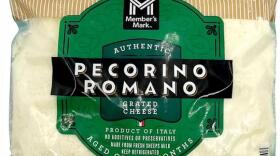Good morning. You're reading the Up First newsletter. Subscribe here to get it delivered to your inbox, and listen to the Up First podcast for all the news you need to start your day.
Uplifting Indigenous stories

For Indigenous Peoples' Day this year, the Up First newsletter is recognizing the work NPR's member stations do to uplift Indigenous voices. The member stations in the NPR network are independent and locally operated. They determine their own schedules and base their reporting on the needs and interests of their communities. Many of these communities feature large Indigenous populations. These are some of the people producing integral reporting to NPR's coverage:
- Sage Smiley, news director for KYUK in Alaska
Smiley has spent her professional career in rural Alaska. Her small team covers a region the size of Oregon, made up of more than 50 villages with no connected road system. KYUK, an Alaska Native-owned media organization, broadcasts daily news, live and recorded programming in Yugtun, the Yup'ik language. "Every decision made at KYUK happens with our Indigenous audience in mind," Smiley says. "The consistent, multifaceted, and nuanced coverage of news and community affairs in both English and Yugtun, on the radio and over public television throughout that history, is a testament to our commitment to serving our audience of Alaska Native and non-Indigenous listeners."
Smiley says she's especially proud of KYUK's coverage of the Cama-i Native Dance Festival in Bethel. It’s one of the largest Indigenous dance festivals in the world. With just two reporters, three multimedia staff, and a Yup'ik language translator, the team produced stories about the pillars of yuraq's resurgence on the Yukon-Kuskokwim Delta, the annual Native foods dinner, the first appearance of a local Filipino dance group at the festival, the crowning of the new Miss Cama-i, the building-shaking 'Heart of the Drums' event, the artisans of the Native Crafts Fair (in English and Yugtun), and interviewed Congressional representative Mary Peltola about attending the festival and her policies. KYUK's coverage works against stereotypes communities in this region face even within the state of Alaska. Smiley says they're often "presented as destitute in a way that does not reflect the beauty, humor, and diversity of the people in the Delta. It's a huge responsibility, and an honor, to live and work in a place where we also go berry picking with, play intramural water polo or volleyball with, or volunteer with the people whose stories we cover. The shared sense of community and purpose in reflecting and amplifying all the facets of the Y-K Delta is incredibly fulfilling."
- Cassie Ordonio, culture and arts reporter at Hawaii Public Radio
"I think Hawai’i Public Radio is best at telling community stories through their lens and uplifting their voices," says Ordonio, who has worked at Hawaii Public Radio for more than a year. "I think HPR does a good job of breaking stereotypes by passing the mic to the communities and having them tell their stories." This year, Ordonio has reported on the cultural appropriation of the uroh, a Pohnpeian skirt. Micronesians say that manufacturers in Pakistan mass produce these skirts and sell them to Micronesian communities in the U.S. for as cheap as $10. The real thing costs on average $100. "I felt that it was important to tell this story because Micronesians face discrimination in Hawaii as the latest migrants and some feel targeted for wearing their skirts. But these cultural fabrics tell their stories through embroidery." Ordonio's next story will explore the intellectual property rights of the urohs and how Pohnpeian seamstresses are passing down their traditions to the younger generation.
- Sarah Liese, Indigenous affairs reporter at KOSU in Oklahoma
"Building trust and credibility is crucial to correcting past wrongs this country was founded on, such as exploitation and stealing," Liese says. "My knowledge of the past through my lens as a Diné and Turtle Mountain Chippewa Two-Spirit person informs how I approach my work and build connections. That means I communicate my intentions to sources upfront and offer a sense of who I am, like sharing my tribal affiliations and the names of my ancestors. When possible, I try to incorporate Indigenous languages, humor, cultural wisdom and historical context to paint a more comprehensive picture. I find this approach reminds our audience of the nuances of tribal nations.”
Liese recently reported on the interment of Kate Ross and Alfred Charko, two Wichita and Affiliated teens who passed away at the Carlisle Indian Industrial School in 1882. She learned in her reporting that Charko could not return home because of a mismarked grave. "The reason behind the burial site error is unknown, but there has been a history of Indigenous children being dug up and reburied at Carlisle. I am proud of this story because it highlights a glossed-over piece of history at one of the most well-known Indian boarding schools. Most importantly, it also honors the lives of Alfred and Kate, who walked on at Carlisle."
Though covering Indigenous issues can be challenging, Liese says the challenges also bring her strength: "The emotional baggage that I carry on my back from my ancestor’s intergenerational trauma carries me toward unpacking the present. It also pushes me toward balancing the moments of devastation with those of joy and humor. As the Oklahoma-based show Reservation Dogs showed the nation, Indigenous people are hilarious. Full stop." Liese describes covering Indigenous matters as "coming home to myself and my ancestors who advocated for Indigenous rights and for us to have a seat at the table where our voices are heard. On the days when I am in tune with the stillness, I feel my Diné grandmother, Mary Morez, standing behind me. I can feel her approval and her pride. To me, that makes the bitter and emotionally draining days worth it.”
Stories you may have missed
The Star Wars universe recently expanded to include multigenerational Anishinaabe speakers who have dubbed Disney's Star Wars (Anangon Miigaading): A New Hope in Ojibwe. Niigaanii-Animikii Inini, a filmmaker and the language-culture coordinator of the Red Cliff Band of Lake Superior Chippewa in northern Wisconsin. He is the voice actor for the character Red Leader in the Ojibwe version of Star Wars and shared his experience of working on the translation of the film. (via WUWM)
For almost six decades, filmmaker Alanis Obomsawin, who is Abenaki, has gained recognition for her documentaries. Her films explore Indigenous people's lives and the challenges they face in Canada. She considers her movies to be one of the most important aspects of her life. “It's about ensuring that all people have a voice—specifically, I'm referring to our people,” she said “However, I believe that every human being requires a platform to express themselves.” (via NHPR)
The Native Games exhibit at the Milwaukee Public Museum was established in 2010 when the state was announced as the host city for the North American Indigenous Games the following year. The games began in 1990 and are held intermittently. Similar to the Olympics, they feature sports such as archery, lacrosse, softball, swimming, and canoeing. The exhibit delves into the origins of lacrosse as an Indigenous game, with versions intended for both men and women. In these cultures, the games were more than entertainment and often helped prepare people for adult roles in life. (via WUWM)
Julia Keefe Indigenous Big Band, an Indigenous Big Band with 16 members, was formed in 2022. This year, it headlined Vermont’s Mary Lou Williams Jazz Festival at the Kennedy Center. The festival annually pays tribute to Williams, known as the "first lady of jazz," and celebrates women who continue to influence the genre. Among them are Julia Keefe, a Nez Perce citizen who leads the Indigenous Big Band, and Mali Obomsawin, an Abenaki citizen of Odanak First Nation who plays bass in the band. In addition to the rich history of oral traditions among Indigenous peoples, their origins in jazz can be traced back to the residential schools in the U.S. and Canada. (via Vermont Public)
On this episode of Talk of Iowa, host Charity Nebbe talks with Johnathon Buffalo, the historic preservation director of the Meskwaki Nation. They discuss the history and significance of the celebration held at the only Indigenous settlement in Iowa. Additionally, Nebbe interviews Stella Youngbear, who has been creating beadwork for 65 years. (via IPR)
Podcast Picks

The Indicator from Planet Money: A short podcast about big ideas, helping you understand current events in work, business, the economy, and more, brought to you by those who make Planet Money.
- 🎧 For over 10,000 years, many peoples in what is now known as North America relied on bison. Some 30 million bison roamed from modern Canada down to Mexico. However, in the late 1800s, hide-hunters and the U.S. military nearly wiped out the creature's population, taking them to the brink of extinction. This had significant consequences for the people who depended on them and still affects us today. In this episode, we hear from an economist who revealed the shocking numbers telling this story and one Blackfeet Nation member trying to bring back the bison.
Code Switch: It's the fearless conversations about race you've been waiting for. Hosted by journalists of color, the podcast tackles the subject of race with empathy and humor. Exploring how race affects every part of society — from politics and pop culture to history, food and everything in between.
- 🎧 The term "reservation" implies that the land is set aside for Native Americans. However, in many cases, reservation land is not actually owned by the tribes. This is the case for the Leech Lake Band of Ojibwe in northern Minnesota, where the tribe only owns a small portion of its reservation land. In contrast, just northwest of Leech Lake is Red Lake, one of the few reservations in the country where the tribe owns all of its land.
Monumental, via Public Radio Exchange: This podcast explores the status of monuments in the U.S. and delves into questions about their past, present, and future.
- 🎧 For generations, Christopher Columbus has been glorified in U.S. monuments. While statues of him have recently started coming down, the largest one in the world still stands tall in the beach town of Arecibo, Puerto Rico. In this episode, reporter and journalism professor Gisele Regatão travels to Puerto Rico and beyond to uncover the roots of Columbus’ glorification in history and why he came to be represented in so many public statues, even though he never actually set foot on the U.S. mainland. She also visits a community artist in Woodside, Queens, who confronts the myth of Columbus by creating new monuments that celebrate immigrant stories.
The Ohio Country, via WYSO: The 12-episode series, provides a perspective on the history of the region we now call Ohio that very few of us learned in school. It puts the experiences of Miami, Shawnee, Wyandotte, and other American Indian people at the center of a refreshed version of the state’s complicated past and undecided future.
- 🎧 In this episode, we define tribal citizenship, look at some of the damage done by “pretendians” in Ohio, and highlight the work of the citizens of federally recognized tribes correcting those situations.
This newsletter was edited by Obed Manuel.
Copyright 2024 NPR








